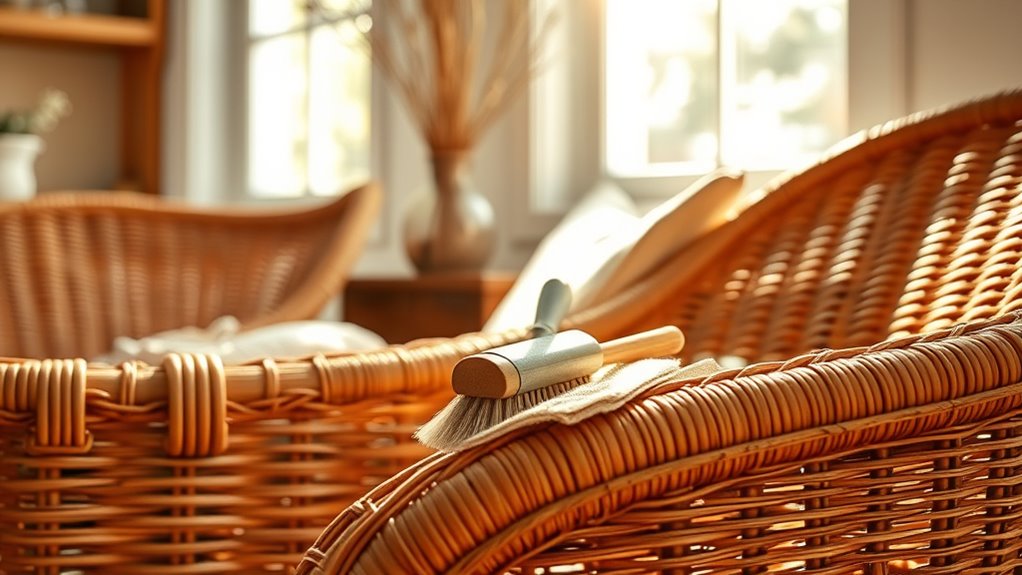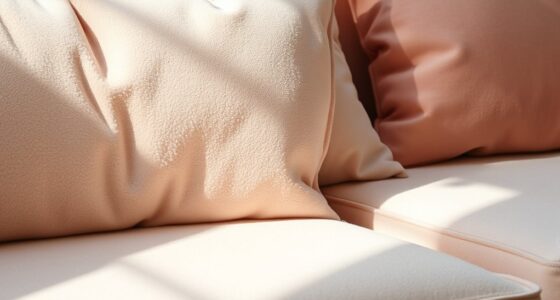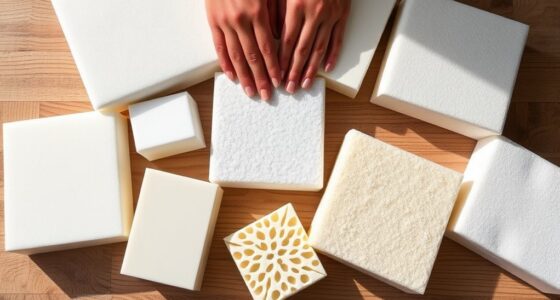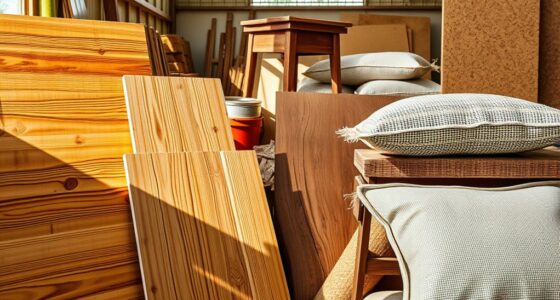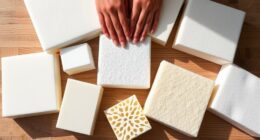To care for your rattan and wicker furniture, clean regularly with a soft cloth or gentle soap and water, avoiding over-wetting. Protect it from harsh sunlight and moisture by using covers and placing it in well-ventilated, dry areas. Apply a protective sealant once or twice a year, and inspect for pests or damage. Proper maintenance extends its lifespan, and you’ll find even more tips to keep your furniture looking great if you keep going.
Key Takeaways
- Dust regularly and clean with a mild soap solution, ensuring not to over-wet the fibers.
- Apply protective sealant or furniture wax once or twice a year for added durability.
- Keep furniture in well-ventilated, dry areas, and use covers outdoors during harsh weather.
- Protect from direct sunlight to prevent fading and fiber weakening, and avoid prolonged exposure.
- Inspect periodically for pests or damage, treating issues promptly and storing properly during off-seasons.
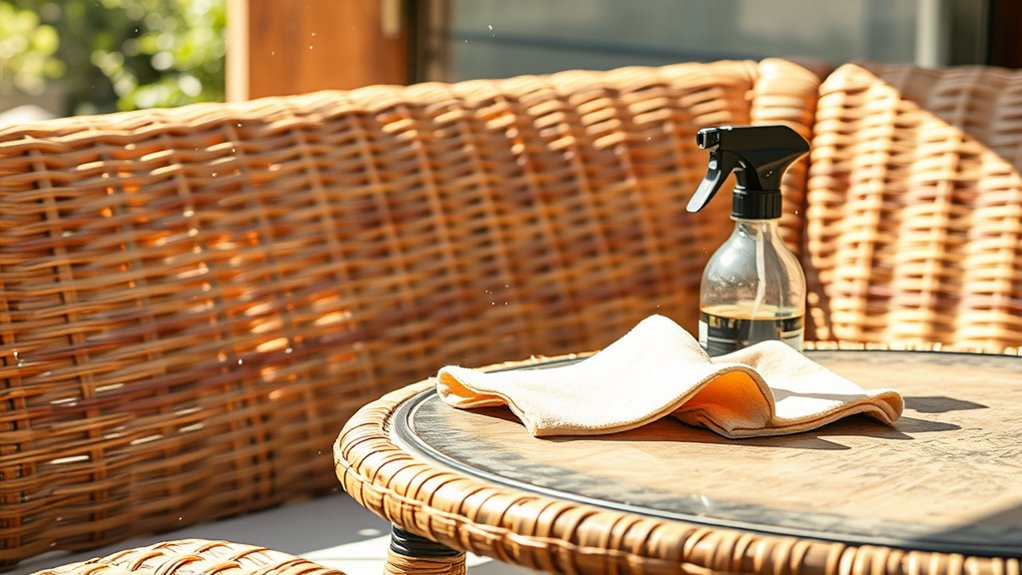
Are you wondering how to keep your rattan and wicker furniture looking its best? The key lies in consistent cleaning tips and preventative maintenance. Rattan and wicker are beautiful, durable materials, but they require proper care to stay in top shape. Regular cleaning helps prevent dirt buildup, which can cause fibers to weaken over time, while preventative measures protect against damage from moisture and pests.
Start by dusting your furniture regularly with a soft cloth or a vacuum with a brush attachment. This simple cleaning tip prevents dust and debris from settling into the fibers and becoming difficult to remove later. For deeper cleaning, mix a gentle solution of mild soap and warm water. Dip a soft cloth or sponge into the solution, wring it out well, and wipe down your furniture. Avoid soaking the material, as excess moisture can lead to warping or mold growth. After cleaning, rinse with a damp cloth to remove any soap residue and dry thoroughly with a towel or allow it to air dry in a shaded area.
Dust regularly with a soft cloth or vacuum to prevent dirt buildup on rattan and wicker furniture.
Preventative maintenance is just as important as regular cleaning. Apply a protective sealant or a furniture wax designed for rattan or wicker once or twice a year. This creates a barrier against moisture and dirt, making future cleaning easier and helping your furniture resist cracking or fading. If your furniture is kept outdoors, consider using furniture covers when it’s not in use, especially during harsh weather. This shields your pieces from rain, snow, and direct sunlight, which can cause fibers to become brittle and color to fade prematurely.
Another preventative tip is to avoid placing your furniture in direct sunlight for extended periods; UV rays can weaken fibers and cause discoloration. If outdoor exposure is unavoidable, rotate cushions and furniture periodically to ensure even wear. Inspect your furniture regularly for signs of pests, such as small holes or frass, and treat any issues promptly with appropriate pest control methods. Keeping your furniture in a well-ventilated area and ensuring it remains dry can prevent mold and mildew growth. Additionally, proper storage during off-season months can significantly extend the lifespan of your outdoor wicker or rattan pieces.
Frequently Asked Questions
Can I Use a Pressure Washer on Rattan or Wicker Furniture?
You shouldn’t use a pressure washer on rattan or wicker furniture because of the pressure washer risks. The high pressure can damage the delicate material, causing cracks or splintering. Instead, opt for alternative cleaning methods like gentle vacuuming, wiping with a damp cloth, or using a soft brush with mild soap. These safer options help preserve your furniture’s integrity while keeping it clean and looking good.
How Do I Prevent Mold and Mildew Buildup?
To prevent mold and mildew buildup, you should keep your furniture dry and well-ventilated. Regularly wipe down the surfaces with a damp cloth and make certain no moisture remains in crevices. Applying a mold prevention spray can help, and you should also store your rattan or wicker furniture in a dry, shaded area during rainy seasons. Consistent mildew control keeps your furniture looking fresh and extends its lifespan.
Is It Safe to Use Bleach on Wicker or Rattan?
A stitch in time saves nine, so you ask if bleach is safe on wicker or rattan. Generally, bleach isn’t recommended for rattan cleaning because it can weaken the fibers and cause discoloration. If you choose to use bleach, make certain it’s diluted and applied sparingly, then rinse thoroughly. Always prioritize gentle cleaning methods to protect your furniture’s longevity and avoid damage.
How Often Should I Replace the Furniture’s Protective Coating?
You should replace the protective coating every 1 to 3 years, depending on its lifespan and exposure to elements. Regularly inspect your furniture for signs of wear, such as cracks or fading. Reapplication frequency is key to maintaining its durability and appearance. If you notice the coating is deteriorating sooner, reapply sooner. Proper maintenance guarantees your rattan or wicker furniture remains protected and looks great longer.
Can I Repair Broken or Cracked Wicker or Rattan Pieces Myself?
Did you know that over 60% of homeowners attempt DIY repairs before calling professionals? Yes, you can repair broken or cracked wicker or rattan pieces yourself. Use wood glue or epoxy for small cracks, and consider rattan restoration techniques like weaving or replacing broken strands. With patience and the right tools, you can restore your furniture’s look and durability, saving money and extending its life.
Conclusion
By following these simple care tips, your rattan and wicker furniture will remain a beautiful, welcoming centerpiece in your home or garden. Think of it as tending to a cherished garden—regular gentle attention keeps it vibrant and full of life. With just a little love and care, your furniture will continue to tell stories of sunny days and cozy evenings, shining like a treasured treasure that ages gracefully, inviting everyone to sit and enjoy its timeless charm.
